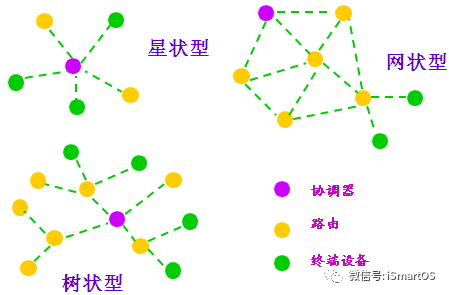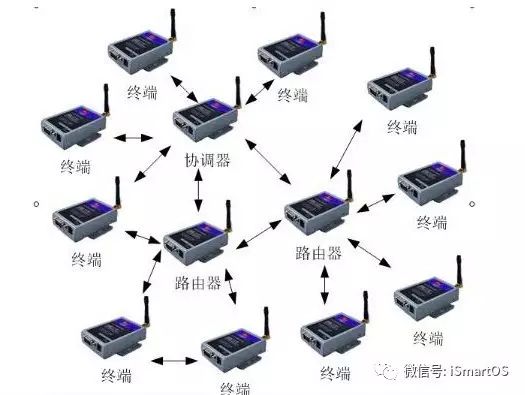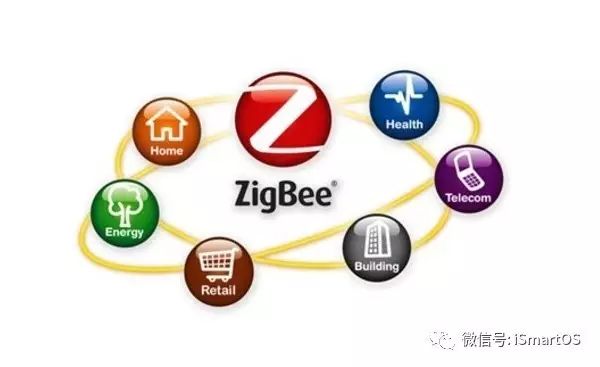When it comes to short-range IoT technologies, besides Wi-Fi and Bluetooth, there is actually another well-known player—ZigBee.

ZigBee has been one of the important wireless communication protocols in recent years, widely used in the IoT field, especially in smart home applications.
Today, let’s take a detailed look at it!
1. Origin and History
1Why Was ZigBee Introduced?
During the use of Bluetooth technology, people found that despite its many advantages, it was too complex for industrial and home automation control and industrial telemetry applications. It had high power consumption, limited range, and small network scale.
Moreover, in industrial settings, reliable wireless data transmission is required to withstand various electromagnetic interferences. Bluetooth technology cannot meet these requirements.
As a result, the ZigBee protocol was officially introduced in 2003.
2Why Is It Called ZigBee?
Bees (bee) communicate with each other by flying and “buzzing” (zig) their wings to convey the location and distance of pollen. This behavior forms a communication network within the colony. Thus, the inventors of ZigBee creatively used this behavior of bees to name it.

3What Protocol Does ZigBee Rely On?
The MAC and PHY layers of ZigBee are based on the IEEE802.15.4 protocol.
This protocol specifies a low-complexity, low-power, low-data-rate, low-cost bidirectional wireless communication technology suitable for automatic control and remote control applications. It can be embedded in various devices while supporting geolocation functions.
4What Are the Features of ZigBee?
The features of ZigBee mainly include the following aspects:
(1) Low Power Consumption: In low-power standby mode, two AA batteries can support one node for 6 to 24 months or even longer. This is a significant advantage of ZigBee. In contrast, Bluetooth can work for weeks, and Wi-Fi can work for hours;
(2) Low Cost: By significantly simplifying the protocol, the cost of ZigBee is very low (less than 1/10 of Bluetooth). Additionally, ZigBee reduces the requirements for communication controllers, with predictions showing that a full-function master node requires 32KB of code, while a sub-function node requires as little as 4KB of code, and the ZigBee protocol patents are free;
(3) Low Data Rate: ZigBee operates at a communication rate of 250kbps, meeting the needs for low-rate data transmission applications;
(4) Short Range: The transmission range is generally between 10 to 100 meters, and can be increased to 1-3 kilometers with increased RF transmission power. This refers to the distance between adjacent nodes. If relay communication is used between routers and nodes, the transmission distance can be further extended;
(5) Short Delay: ZigBee has a fast response speed, generally taking only 15ms to transition from sleep to active state, and 30ms for a node to connect to the network, further saving energy. In comparison, Bluetooth takes 3-10 seconds, and Wi-Fi takes 3 seconds;
(6) High Capacity: ZigBee can adopt star, mesh, and cluster network structures, with one master node managing several sub-nodes, and a single master node can manage up to 254 sub-nodes; additionally, the master node can be managed by higher-level network nodes, allowing for a large network of up to 65,000 nodes;
(7) High Security: ZigBee provides three levels of security, including no security settings, access control lists (ACL) to prevent unauthorized data access, and symmetric encryption using the Advanced Encryption Standard (AES128) to flexibly determine its security attributes;
(8) Free Frequency Band: It operates in the Industrial, Scientific, and Medical (ISM) frequency bands at 915MHz (USA), 868MHz (Europe), and 2.4GHz (globally), without needing to pay for frequency usage.
In summary, ZigBee has many advantages.
5What Are the Network Features of ZigBee?
ZigBee technology uses a mesh topology, supporting automatic routing, dynamic networking, and direct-sequence spread spectrum. These features meet the requirements of industrial automation control (low data volume, low cost, low power consumption, high reliability).

2. Communication Technology
1Why Is ZigBee Said to Use Free Frequency Bands?
In most countries around the world, using radio devices requires payment of frequency usage fees, including mobile communications. However, mobile operators or service providers have already paid this fee to the state and charge users through various means.
The free frequency band refers to a band designated by each country based on its actual situation, considering consistency with the regulations of other countries, specifically for industrial, medical, and scientific research use (ISM band), which can be used freely without application.
The 2.4GHz band in our country is such a band.
However, to ensure reasonable use by everyone, the state has imposed corresponding limits on the usage power of wireless transceivers in this band under different environments. For example, in urban environments, the transmission power cannot exceed 100mW.
2Is ZigBee Only Suitable for Short-Distance Communication?
ZigBee local area networks can not only expand the network by increasing the transmission power and receiving sensitivity of each node module and increasing the number of nodes but also monitor distant ZigBee control networks through traditional internet.
However, it is important to note:
(1) As transmission power increases, power consumption naturally increases, which would negate ZigBee’s inherent advantage of low energy consumption;
(2) Although 2.4GHz is a free frequency band, it cannot exceed the maximum power limits specified in the radio wave law.
Therefore, ZigBee is generally used in short-distance communication scenarios.
3What Are the Benefits of ZigBee’s Direct Sequence Spread Spectrum Communication Method?
Using the same frequency band but different communication methods can yield significantly different results. For instance, the anti-interference ability, communication security, and reliability of ASK, FSK, FHSS, DSSS, etc., vary.
ZigBee systems, like CDMA systems, adopt direct-sequence spread spectrum technology (DSSS), which has strong anti-interference capabilities and high confidentiality and reliability.
Spread spectrum technology requires a low signal-to-noise ratio during normal communication. In other words, it can still work normally in environments with strong interference. According to calculations and experiments, this is equivalent to a 7dBm increase in receiving sensitivity. It is also less likely to interfere with others.
In other words, it can transmit over longer distances using lower power (with a transmission power of 0dBm, Bluetooth typically has a range of 10 meters, while ZigBee can reach 30-50 meters indoors and even 400 meters in open outdoor areas).
4Why Does ZigBee Have Better Anti-Interference Performance Than Wi-Fi and Bluetooth Technologies?
ZigBee’s anti-interference characteristics mainly refer to its resistance to co-frequency interference, which is interference from other technologies using the same frequency band.
The main features are as follows:
1. Clear Channel Assessment (CCA):
Determines whether the channel is clear. The IEEE 802.15.4 physical layer provides CCA capability in the collision avoidance mechanism, allowing transmission to exit if the channel is occupied by other devices without considering the communication protocol using that channel.
2. Dynamic Channel Selection:
The coordinator in a ZigBee personal area network (PAN) (the central node responsible for organizing and maintaining the network) scans all channels, confirms, and joins a suitable PAN (without needing to create a new PAN), reducing the number of overlapping PANs to lower potential interference. If an interference source appears on an overlapping channel, the coordinator’s upper-level software applies channel algorithms to select a new channel.
3. Channel Algorithm:
During network initialization or in response to interruptions, ZigBee devices scan a series of channels listed in the channel table parameters for dynamic channel selection, setting the channel table parameters according to the aforementioned clear channels to enhance network coexistence performance.
During severe interference, ZigBee does not change channels but relies on its low duty cycle and non-conflict algorithm (each device listens to the channel before sending data) to reduce data loss due to transmission conflicts.
4. Direct Sequence Spread Spectrum (DSSS) and Frequency Hopping (FA):
Direct sequence spread spectrum technology has certain anti-interference effects, and under the same conditions, the transmission distance is greater than hopping frequency technology. Frequency hopping involves changing frequencies to avoid the influence of known interference sources or signal sources.
As shown in the diagram above, ZigBee’s bit error rate can reach 10-9 at a signal-to-noise ratio of 4dB, while Wi-Fi requires 10dB and Bluetooth requires 16dB to achieve the same bit error rate, indicating that ZigBee’s anti-interference performance is significantly better than that of Wi-Fi and Bluetooth technologies.
5. Acknowledgment Retransmission and Frame Buffering:
ZigBee’s MAC layer and application layer (APS part) have automatic request retransmission (ARQ) and frame buffering capabilities. When sending data frames to devices, if the receiving device is busy or in sleep mode and cannot receive the frame, the network’s main coordinating device temporarily buffers the frame until the receiving end can accept it.
Although the modulation method is simple, ZigBee demonstrates excellent anti-interference performance in the 2.4GHz ISM band, making it very suitable for low-power, low-data transmission applications.
3. Network Technology
1What Kind of Wireless Data Transmission Network Does ZigBee Have?
ZigBee is a wireless data transmission network platform composed of multiple wireless transmission modules (up to 65,000), quite similar to existing mobile communication networks. Each ZigBee network transmission module is like a base station in a mobile network, allowing mutual communication within the entire network range; the distance between each network node can range from the standard 75 meters to several hundred meters or even kilometers when extended.
Unlike mobile communication networks, where each base station is generally very expensive, each ZigBee “base station” is very inexpensive.
Each ZigBee network node can serve as a monitoring object itself, such as directly collecting and monitoring data from connected sensors, and can also automatically relay data from other network nodes.
Furthermore, each ZigBee network node (FFD) can wirelessly connect with multiple isolated sub-nodes (RFD) that do not undertake network data relay tasks within its signal coverage area.
2What Is ZigBee’s Self-Organizing Network?
A simple example can illustrate this issue: when a group of paratroopers lands, each holding a ZigBee network module terminal, after landing, as long as they are within the communication range of the network module, they can quickly form an interconnected ZigBee network by automatically searching for each other. The modules can also refresh the original network by re-establishing communication with each other. This is the self-organizing network.

3Why Does ZigBee Use a Self-Organizing Network for Communication?
Mesh network communication essentially involves multi-channel communication. In actual industrial settings, various reasons often prevent every wireless channel from remaining unobstructed, just like urban streets, which may be temporarily blocked due to accidents or road maintenance.
In such cases, having multiple channels allows vehicles (equivalent to our control data) to still reach their destination via alternative routes. This aspect is crucial for industrial control.
4Why Does the Self-Organizing Network Use Dynamic Routing?
Dynamic routing means that the path for data transmission in the network is not pre-defined. Instead, before transmitting data, all available paths in the network are searched, their positional relationships and distances analyzed, and one of the paths is selected for data transmission.
In our network management software, the path selection uses a “gradient method,” which first selects the nearest path for transmission. If it fails, it tries another slightly farther path, and so on, until the data reaches its destination.
In actual industrial settings, pre-defined transmission paths can change at any time, either due to various reasons causing interruptions or being too busy for timely transmission. Dynamic routing combined with mesh topology effectively addresses this issue, ensuring reliable data transmission.
4. Market Applications
1What Are the Application Areas of ZigBee Technology?
ZigBee technology targets industrial, home automation, telemetry, and remote control applications, such as automatic lighting control, wireless data collection and monitoring of sensors, oil fields, electricity, mining, and logistics management.

2How Can ZigBee Expand Its Applications?
ZigBee has a very broad application range, targeting industrial automation, home automation, telemetry, automotive automation, agricultural automation, medical care, oil fields, electricity, mining, and logistics management.
Examples of practical applications include: lighting control, environmental control, automatic meter reading systems, various curtain controls, smoke sensors, medical monitoring systems, large air conditioning systems, set-top boxes and universal remote controls with built-in home control, heating control, home security, and industrial and building automation.
Additionally, it can locate moving targets within a specific area, such as vehicles in a city.
4What Conditions Should Short-Distance Communication Meet to Consider Using ZigBee Technology?
Generally, short-distance communication that meets any of the following conditions can consider applying ZigBee:
(1) A large number of points requiring data collection or monitoring;
(2) Low data transmission volume, but low equipment cost is required;
(3) High reliability and security are required for data transmission;
(4) Small device size is required, making it inconvenient to place larger batteries or power modules;
(5) Battery power supply is feasible;
(6) Complex terrain with many monitoring points requires extensive network coverage;
(7) Coverage for blind spots in existing mobile networks;
(8) Remote control systems that have already used existing mobile networks for low data transmission.
5What Is the Current Application Status of ZigBee Technology in Our Country?
Although many people in the country have begun to pay attention to this new technology and many companies have started to engage in the development of ZigBee technology, considering that ZigBee itself is a new system integration technology, the development of application software must combine network transmission, radio frequency technology, and underlying software and hardware control technology, which poses certain technical challenges for early-stage development companies. Due to various constraints, large-scale commercial application of ZigBee technology still has a long way to go.
However, it has already demonstrated extraordinary application value, and with the development and promotion of related technologies, it will certainly see greater applications.
5. ZigBee 3.0 Technology
1Background of ZigBee 3.0 Development
At the inception of the ZigBee protocol, to meet various application backgrounds, the ZigBee Alliance issued different application layer protocols to meet the needs of different fields:
ZigBee Home Automation (ZigBee HA) → Smart Home
ZigBee Light Link(ZigBee LL) → Smart Lighting
ZigBee Building Automation(ZigBee BA) → Smart Buildings
ZigBee Retail Services(ZigBee RS) → Smart Retail
ZigBee Health Care(ZigBee HC) → Smart Health
ZigBee Telecommunication services(ZigBee TS) → Smart Communication Services

The issue is that these application layer protocols are independent and do not interoperate.
Due to poor standardization in early ZigBee versions, manufacturers were given too many choices. Many manufacturers adopted the ZigBee HA protocol, but home automation manufacturers customized ZigBee HA according to their needs rather than using the standard ZigBee protocol, resulting in products from different manufacturers still being unable to interconnect.
The ZigBee Alliance has struggled with the standardization issue of ZigBee HA. To address this, they have organized a group of organizations to perform ZigBee HA certification, such as the latest ZigBee HA1.2 certification, where products passing this certification can achieve interoperability.

However, the problem remains unresolved. It can be said that ZigBee has only addressed the connection issue of smart devices but has not resolved the interconnectivity issue of smart devices.
2The Emergence of ZigBee 3.0
In May 2016, ZigBee Alliance, in collaboration with members of the ZigBee Alliance China group, held a press conference and ribbon-cutting ceremony at the CES Asia in Shanghai, officially launching ZigBee 3.0 in the Asian market.

The main task of ZigBee Alliance in launching ZigBee 3.0 was to unify different application layer protocols, solving the interconnectivity issues between different application layer protocols. Users can control smart devices from different manufacturers based on ZigBee 3.0 by purchasing any ZigBee 3.0 gateway.
ZigBee 3.0 unified the discovery, joining, and networking methods of ZigBee devices using different application layer protocols, making the networking of ZigBee devices more convenient and standardized. Additionally, ZigBee 3.0 further enhanced the security of ZigBee networks.
The ZigBee Alliance also introduced ZigBee 3.0 certification to standardize the use of the standard ZigBee 3.0 protocol by various manufacturers to ensure interoperability of devices based on ZigBee 3.0.
3The Future of ZigBee 3.0
ZigBee 3.0 resolved the interconnectivity issues between different application layer protocols and further standardized the ZigBee protocol, taking a significant step toward interoperability in smart homes.
However, ZigBee still needs to continue working on interoperability with other protocols. This also requires different protocol (or standard) providers to collaborate and compromise on underlying protocols, which may be a challenging process.
This is destined to be a long-term mission with significant challenges ahead.
Author: Wulian_chen (WeChat public account: Smart IoT Life)
Layout: Xiaozhao Jun

